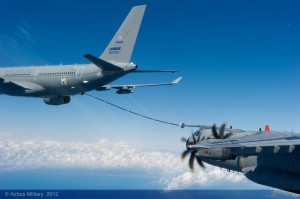2013-06-06 Airbus Military is the 21st Century version of CASA. As such, it combines the CASA heritage, and the C-212, and CN-235 with new products, notably the new A330MRTT tanker and the strategic-tactical blend of an airlifter, the A400M.
At the Trade Media Brief held at the end of May 2013, a relative newcomer to the company, and a senior Royal Air Force officer, explained how these new products would intersect with operations and create some new capabilities.

Air Commodore Ian Elliott studied Aeronautics and Astronautics at Southampton University. He graduated from the RAF College Cranwell in 1982 and flew VC10s during Gulf War 1. Following tours in the Ministry of Defence, he served at RAF Brize Norton as a squadron commander in 1999 and led his Squadron in the Kosovo War after which he was awarded the OBE by Her Majesty the Queen.
He then commanded the RAF ́s only strategic air transport base in 2004, and was appointed an Aide De Comps to Her Majesty the Queen. Promoted to Air Commodore, he served as Assistant Chief of Staff for Strategy, Policy and Plans within HQ Air Command before being appointed as the UK Air Attaché to Washington DC in 2008.
On retiring from the RAF in early 2011, Ian took up a post as Airbus Military ́s Head of Defence Capability Marketing.
The title of his presentation to the Trade Media journalists was “The Transformational Operational Impact of Airbus Military’s Products.”
What he did in the presentation was to examine a small number of operational cases and lay down a what if look at the potential impact of the new Airbus Military air platforms on those operations.
The Libyan Operational Case and the Role of Tankers
The first case was that of the decision by the UK to strike Libya from UK-based fighters with an initial Storm Shadow cruise missile strike. It was the longest UK bombing mission run since the Falklands War. To carry out the mission required significant use of UK tankers, and given the age of those tankers, UK airmen had to deploy a reserve force to ensure that the target was hit.
This meant that there were three refueling brackets to Libya and two necessary to get back. In physical terms, this meant that two of the aging VC-10s and 1 Tristar were necessary to support 4 Tornados conducting the strike. And to ensure mission success it was necessary to have two additional VC-10s running standby and one on ground alert.
The UK then operated tankers from Cyprus, where the UK had an RAF base. Eventually, they were able to move the tankers to Sicily to operate. This reduced the operational distance necessary to provide tanking.
This is important because tankers have one bucket of fuel onboard. They either fly and burn it all themselves or they can give it all away. And the longer you spend transiting from A to B, the less fuel you have to give away. So it’s a massive inefficient use of a tanker airplane to spend four hours flying up and down the Mediterranean to get to where it must do its job of refueling combat assets.
Another aspect of the operational challenge highlighted was the time lag necessary to deal with the air threat and creating a situation where you can bring your tankers further forward into an operation. Air superiority is not a given, and until it is assured, tankers have to operate further back. This in turn creates a burn rate problem, whereby the tankers burn more fuel proportionate to the delivery of fuel to combat assets, whether strike or ISR or C2 aircraft.

The operation started in March, but not until September could the tankers operate forward over Libyan territory. Tankers are a precious asset, which needs to be protected and not operated too far forward to reduce the risks to the tankers and to the operation. If you shoot down a tanker, the war stops because tankers kept this war going. The entire operational center of this operation was driven by tanker availability.
In many ways, the Libyan operation was a tanker-supported operation.
Nine nations provided tankers; 16 nations provided 27 types of aircraft receiving fuel or 260 aircraft in total. This meant that of the 26,500 sorties flown during the eight-month campaign, 25% were tanker missions.
Elliott then addressed the question of how this can be done more effectively. If the tankers could have operated further forward, then the operational tempo is improved and more efficient use of the tankers themselves results. The legacy tankers are simply too old and their flight time is much lower than needed because of their age. And legacy tankers tend not to be multi-point tankers and when you have a coalition using different types of aircraft, such capability matters.
The old tankers out there with single hoses were of limited utility and we wanted reliable and available tankers. They were also taking up rack space in the Mediterranean area of operation.
Elliott argued that the size of the A330MRTT and its ability to provide for multi-point tanking would have led to a significant enhancement of not only tanker efficiencies but overall combat efficiency and effectiveness.
And as a new tanker built around the commercially demonstrated highly reliable A330, the readiness rate would be much higher than for the current legacy fleet of tankers.
When it comes to tankers, size matters. You step back and think what you could do with one, two, three or four of these assets in the sky. It will transform – strong word but I think it’s appropriate – how the military can think about conducting their business.
It means you can now move interesting things an awfully long way away from where you are based. That Storm Shadow raid that took five tankers could be down to two for instance. Or, if you have basing right issues or if you’re falling out with one of your neighbors who doesn’t want you to park airplanes there, you park three or four of these in the sky, and you basically got an airborne airfield. You can transform how military planners think about planning refueling missions.
The self-protection systems on the aircraft will allow you to operate it differently as well.
I will highlight the fact that we are providing these airplanes with a massively comprehensive suite of defensive planes. These airplanes will be well protected, so the militaries of the world will be able to operate where they want to work. In terms of airborne refueling efficiency and parking of tankers where you really want to use them, the military will be able to do that for the first time ever in the air refueling arena.
Additionally, he highlighted the carrying capability of the A330MRTT as well and its usefulness in the sort of air campaign one saw in Libya.
But let’s not forget that this is a multi-role, MRTT airplane with significant strategic transport capabilities. If I wanted to take four fast jets from Europe to America for instance, typically you take maybe 50 people, a few tons of spare parts, and if I want to do it, up to now I would have taken a tanker airplane and a couple of group support airlift airplanes to ensure that I would have the inventory of everything I wanted. The under-floor capacity of this airplane is astonishing. It will carry more than an A400 will carry just underneath the floor. In terms of effectiveness and efficiency, it’s a massive game change improvement.
The Mali Operational Case and the Coming of the A400M
Elliott then turned to the case of the potential impact of the A400M on an operation like that going on in Mali.
What the French ended up doing is moving all their equipment in borrowed or chartered strategic airlifters down to the capital, Bamako, which was a long way away from where they actually wanted to use the men and the machinery. They ended up with massive overland ground convoys. Some of these convoys were hundreds of miles long and this was a 900 km journey. That involved massive risk. The vulnerability of moving that many people and that much kit by road, but they had no alternative.
(For a look at convoys in Mali see the following:
https://sldinfo.com/the-french-operation-in-mali-the-logistics-side/).
Elliott argued that the A400M could have carried all of the core equipment used by the French, and in fewer loads and to areas closer to the operation.
This would lead to greater efficiency in the operation and would enhance the speed of operations, and combat speed is a crucial quality for any operation, particularly one like this.
The troops who were operating in the northern part of Mali and indeed still are have vital requirement for food and water. Right now, what we’re trying to solve is doing all return trips per day to deliver water to the most northern-based troops in this operation. You take an A400, it’ll take two days worth of water in one trip because it can carry the weight; it can carry the mass.
The ability of the A400M to carry C-17 type loads to the point of attack, as does the C-130 will be a significant game changer.
The A400M could have airlifted heavy and outsize loads directly to the point of need.
(On the key role of expeditionary logistics for the evolution of operations see the following:
https://sldinfo.com/reshaping-the-combat-force-with-expeditionary-logistics/
https://sldinfo.com/the-french-in-mali-shaping-the-logistics-element-of-the-operation/).
And the ability of the A400M to do so will be facilitated by the evolution of the defensive gear carried by the aircraft as well.
In the same way that defensive aids were a key requirement in MRTT, this will be the most well defended air transport asset on the battle. So you are reducing risk and exposure to those combat forces that you’ve got onboard the aircraft.
In short, Elliott laid out the case of how the evolution of 21st century operations was facilitated by the new air systems being introduced by Airbus Military.
The briefing delivered by Elliott can be seen below:
For additional pieces of interest see the following:
https://sldinfo.com/the-coming-of-the-a400m-the-mali-hypothesis/
https://sldinfo.com/the-french-in-mali-phase-two/
https://sldinfo.com/the-french-operation-in-mali-intervene-leverage-and-withdraw/
And for our look at the Libyan operations see the following as well:
https://sldinfo.com/focuspublications/the-french-air-force-in-the-libyan-operation/
https://sldinfo.com/the-role-of-airpower-in-21st-century-operations/
https://sldinfo.com/french-army-light-aviation-alat-during-the-libyan-operations/
https://sldinfo.com/the-role-of-helicopters-in-french-army-operations/
https://sldinfo.com/air-mobility-a-proven-concept-for-the-french-forces/
https://sldinfo.com/the-libyan-air-operation-a-french-perspective/
https://sldinfo.com/libyan-lessons-learned/
https://sldinfo.com/the-rafael-in-the-afghan-operations-reconnaissance-pods-used-effectively/
https://sldinfo.com/the-libyan-operation-comparing-the-french-and-usmc-experiences/

